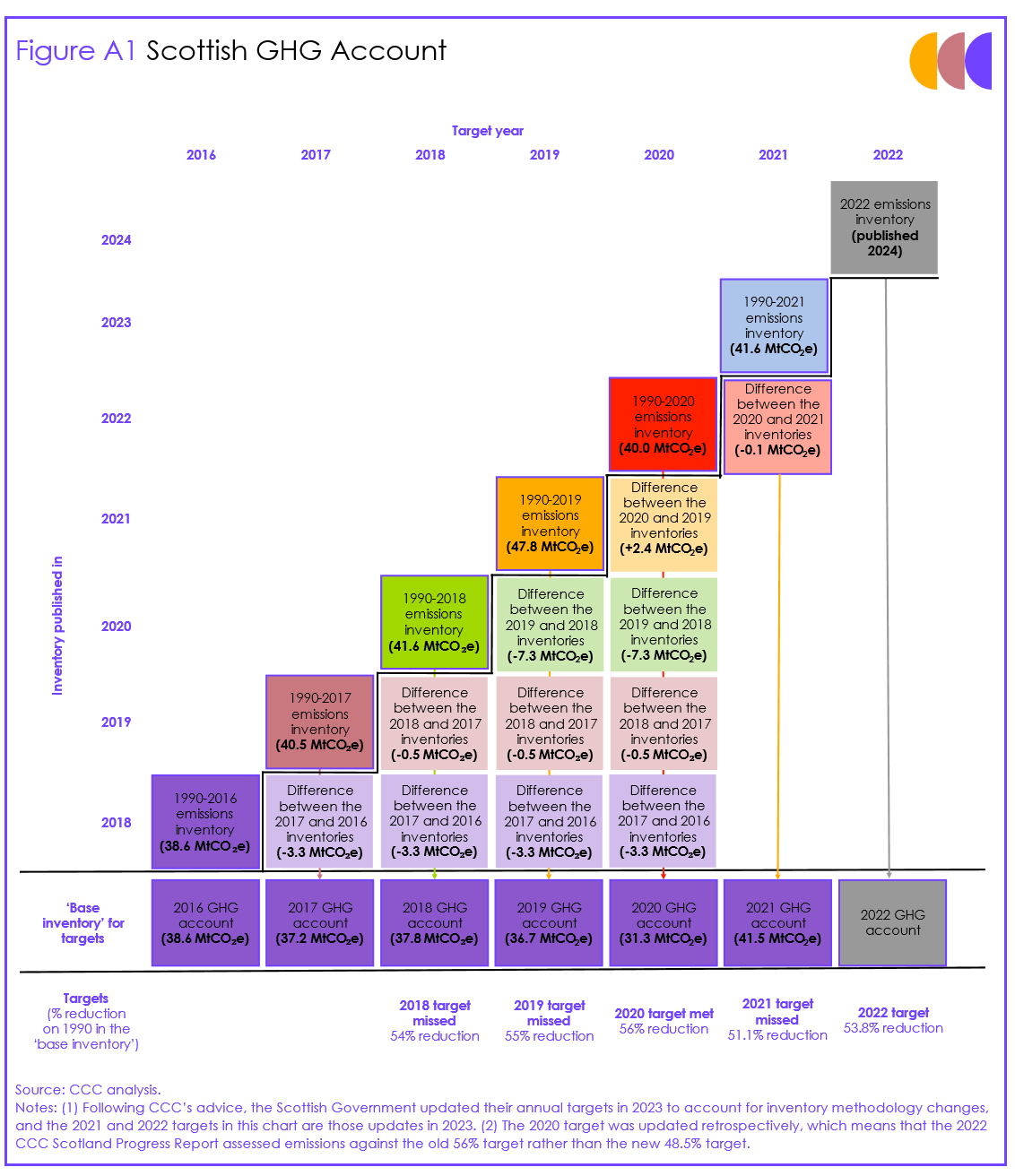Contents
Annex 2 - Methodology
GHG Account methodology
Box A1 explains the Scottish Greenhouse Gas (GHG) Account, which is the methodology used to determine compliance with Scotland’s legislated climate targets.
Box A1Scottish GHG Account |
| Scotland’s emissions targets are assessed against the Scottish Greenhouse Gas (GHG) Account, a methodological approach used to adjust annual emissions to the methodology of the ‘base inventory’, which is currently the 1990 to 2020 inventory. This way, the impact of changes in methodology in determining whether Scotland has met each annual target is minimised.
Methodology changes to the emissions inventory are designed to increase the transparency, accuracy, consistency, comparability, and completeness of emissions estimates. These can come from updates to use more accurate emissions factors and/or activity data, from changes to the internationally agreed global warming potentials of greenhouse gases, and to changes in the scope of the inventory, such as the recent update to the treatment of emissions from peatlands. Scotland is particularly susceptible to changes due to the large contribution from the land use sector, which has large uncertainties and tends to change more significantly than other sectors. The GHG Account allows for annual emissions data to be assessed against targets while accounting for inventory changes, but not changing the target. In any given year the GHG Account is estimated by the following steps (illustrated in Figure A1):
Source: CCC analysis. |
Categorisation of sectors
Table A2 below sets out the differences between the CCC’s sector categorisation and the one used by the Scottish Government for its Climate Change Plan update (CCPu), published in 2020. The analysis of emissions in Chapter 1 follows the CCPu’s sector categorisation, while the policy assessments in the rest of the report are based on the CCC’s sectors.
Table A2Sectors in the Scottish Government’s 2020 Climate Change Plan update (CCPu) vs CCC sectors |
|
| CCPu sectors | CCC sectors |
| Transport | Surface transport, aviation, shipping |
| Industry | Industry, fuel supply, some of the F-gases |
| Buildings | Non-residential buildings, residential buildings, some of the F-gases |
| Agriculture | Agriculture |
| Electricity supply | Electricity supply |
| Waste | Waste |
| Land use | Land use |
| Engineered removals | Engineered removals |
Key for policy scorecards
The assessments of policies and plans in Chapters 2 and 3 focus on the credibility of the Scottish Government’s policies and plans for achieving the levels of emissions reductions that are required. This is a qualitative assessment and does not reflect a quantified gap in emissions reduction between the current status of policies and plans and the set targets. Criteria used for the assessments can be found in Table A3.
Table A3Scoring criteria for assessing policies and plans |
|
| Score | Criteria |
| Credible plans (G) | Indicators are moving in the right direction or being maintained at a high level. |
| Some risks (Y) | Some adjustment to plans may be needed to mitigate uncertainties and delivery or funding risks. |
| Significant risks (O) | Plans under development and/or further work needed to enact policies and overcome uncertainties and delivery or funding risks. |
| Insufficient plans (R) | Plans are either missing, clearly inadequate, or lack funding, and new proposals are needed. |
| Reserved | Plans have not been scored due to the policy area or sub-sector being fully reserved. been scored due to the policy area or sub-sector being fully reserved. |
| Mostly reserved | Plans have not been scored due to the policy area or sub-sector being mostly reserved. |
In addition, as there are many sub-sectors or policy areas where decarbonisation also depends on actions taken by the UK Government, we have separately included an assessment (low, medium, or high) of the extent of the risk posed by UK Government actions within the narrative for each sub-sector in the scorecards.
This assessment is scored on the following criteria:
- High: there is a high dependency on the UK Government for progress in this area, and a high probability of them not taking the action necessary in time for Scotland to make sufficient progress.
- Medium: there is either a high dependency on the UK Government but a low probability of that being an issue, or a low dependency but a high probability of it being an issue.
- Low: there is both a low dependency on the UK Government and a low probability of that being an issue.
This is highly relevant in sectors or sub-sectors where policy is mostly reserved; for sectors or sub-sectors where decision-making is mostly devolved to the Scottish Government, the score is meant to account for indirect impacts that could affect progress in that area.


